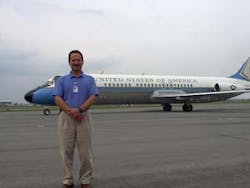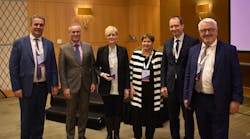I wrote an article titled “Back to Your Future — Is this a great time to head back to school?” for the August 2009 issue. It was about AMT training, continuing education, and the current activity of four outstanding AMT schools. Apparently this article was timely because it generated queries to the schools and phone calls to me. One call was from Greg Larsen. Greg didn’t want to go back to school; he wanted to build a school. My first comment was, “WOW! You have taken on a huge challenge.” My next thought was here is a man that really believes in the future of aviation.
When I interview people for these articles I always ask them about their relationship to aviation and specifically to maintenance. Having read Larsen’s biography, I knew that he had never been involved in aviation maintenance so I asked him to tell me his story. He said that his interest was probably genetic. His grandfather, Agnew E. Larsen, was an aircraft design engineer for Pitcairn Aviation and designed the Pitcairn Mailwings used to carry air mail for the U.S. Postal Service, and the unique Autogyros. (One of Larsen’s PA-5 Mailwings is displayed in the Air and Space Museum in Washington, D.C.) Pitcairn was sold and after a couple of name changes became Eastern Airlines.
Larsen is the business development manager for the Hagerstown, MD, Regional Airport (HGR), which is located in Western Maryland and has been in operation for about 80 years. The airport and surrounding area have long been associated with aircraft manufacturing and maintenance.
From 1931 to 1984, Fairchild Aircraft was located there and HGR gained the nickname “Home of the Flying Boxcar.” Today HGR is served by Allegiant and Cape Air, and AgustaWestland Inc., Northrop Grumman Corp., and Sierra Nevada Corp. have operations there. The West Virginia Air National Guard Base, Patuxent River Naval Air Station, and BWI, IAD and DCA facilities are a few miles away. HGR employs around a thousand persons and has an annual economic impact of more than $100 million.
Need: Aviation work force
Employed by Washington County, Maryland, Larsen is responsible for ensuring this economic engine continues to run and grow. One of his key tasks is to help develop a skilled work force to meet the needs of the airport’s business community and the local aviation related companies.
Hal Lucas, director - special projects Integrated Mission Systems for Sierra Nevada Corp., advised Larsen that “our critical need is skilled touch labors,” meaning AMT graduates with an A&P from a certified school that trains AMTs using modern aerospace technologies.
The HGR “wrench and rivet gun” workforce that built the Flying Box Cars and the A-10s for Fairchild was not available or probably did not have the necessary training. Lucas and other company managers were experiencing the graying of our aviation work force and shortages of technicians that can manufacture and maintain current aerospace technologies — a serious limiting factor to corporate success.
Solution: Certified maintenance school
In early 2006 Larsen began to research a solution to the work force needs of the HGR aviation companies by analyzing data and having discussions with development experts like Anne Anikis, previously with NASA’s Maryland Space Grant Consortium. Anikis, “his stalwart collaborator,” helped Larsen formalize the proposal that asserted the best solution was a federally certified aircraft maintenance technician school, at or near the airport. Larsen began to socialize his plan around town and started down a challenging path.
In my opinion, good development people like Larsen are nothing short of miracle workers. They have tenacity, perseverance, and are great diplomats. Their strength is the uncanny ability to keep a variety of entities focused and committed to a goal — that an A&P school at HGR was the right solution to local work force needs. Through 2006 and 2007 Larsen developed support and alignment from various groups like the Washington County Commissioners and Hagerstown-Washington County Economic Development Commission. The pressure for the solution increased when AgustaWestland located to HGR in the fall of 2007; however, getting and keeping support, commitments, and funding especially during economic downturns is always a challenge.
In 2008 he pitched his idea to some local and state educational institutions. They were interested but seemed more focused on electronics, communications, medical, and other green technologies, not aviation. Larsen persevered, continuing to look for ways to get his A&P school built. The pressure again increased in October of 2009 when Sierra Nevada Corp. (Hagerstown) won a $610 million contract with the Department of Homeland Security’s Customs and Border Protection division.
Developing the business plan
Somewhere along the way Larsen realized he was part of the problem. In one of our interviews I asked him if he had started with a process or project plan for this initiative. He laughed and said no. He thought that the need was apparent and the A&P school solution was so logical that funding and implementation would follow with ease.
Most truthful project managers will tell you that there comes a time in a project, usually in one of those long sleepless nights, when you truly understand what you are up against. According to Larsen he had two such moments.
In the spring of 2008 Pittsburgh Institute of Aeronautics (PIA) expressed interest in developing an A&P program at HGR. The first enlightenment came on June 26 when he visited PIA’s facilities and realized the scope and scale of his initiative. A&P schools are big, physical, equipment heavy, and project intensive technical schools. Also, they are complicated education entities due to the industry’s strict and complex requirements, rules, and regulations. Larsen returned to HGR and back to the drawing board. After additional analysis and discussions with colleagues and various committees, they refined their goals and objectives. The analysis indicated that the need for an AMT program at HGR was more critical than ever. They all agreed on these key factors:
• The program must be FAA certified college or university; accreditation would be advantageous but not critical.
• The program must be broadly supported by the region’s aerospace industry.
• The earliest realistic start date would be fall of 2010.
Larsen developed a comprehensive business plan, continued discussions with HGR and area businesses, and had discussions with various committees and elected officials, including local school officials to Maryland Senator Barbara Mikulski. The project was gaining traction but still had some hills to climb. I had an opportunity to look at one of Larsen’s to-do lists with the following four items:
• Facility
• Funding
• FAA approval
• College/university affiliation(s)
My reaction: Please just shoot me.
Show-and-tell
Larsen realized that his second challenge was how to clearly demonstrate the aviation work force need and its significant economic potential to HGR, and talking only would never get him to his objectives. In a news article, he said, “It was very hard for me to explain to somebody who is an engineer or a mechanic or a technician what it is that these companies are doing, so the thought was to provide them with a firsthand view of the floors of the operations and to provide them with an opportunity to hear firsthand from the principals of those operations what their vision is.” His approach for this problem was one that diplomats have used with great success. It was time for a party with a lot of show-and-tell and face-to-face discussions.
Larsen needed to send out some invitations and had read the August 2009 AMT article, “Back to Your Future” about AMT education. He emailed me in September 2009 asking for a top 10 list of the schools, colleges, and institutions in the United States that offer AMT programs.
I recommended four or five institutions. The HGR “Fam Tour” was held on Dec. 2, 2009 during which Embry-Riddle Aeronautical University, National Aviation Academy, Pittsburgh Institute of Aeronautics (PIA), Spartan College of Aeronautics and Technology, and the University of Maryland-Eastern Shore toured the AgustaWestland Inc. facilities. National, Spartan, and PIA expressed interest in establishing an AMT program in Hagerstown. Was Larsen’s show-and-tell party a success? On May 11, 2010, Herald-Mail writer Heather Keels reported:
“Pittsburgh Institute of Aeronautics to Open School at Hagerstown Regional Airport”
“WASHINGTON COUNTY — The Pittsburgh Institute of Aeronautics plans to open a school at Hagerstown Regional Airport early next year to train a local work force for aviation maintenance technician jobs, PIA director James Mader said Tuesday.
The program is expected to start in January or early February and will enroll 25 students in its initial class, Mader said. Additional groups of 25 to 50 students can begin training every four months, he said.
I called Dr. Jim Mader to ask what had helped PIA commit to a program at HGR. He said that they had considered “several key factors.” PIA had drawn a theoretical “circle” of influence around Pittsburgh and felt that it would be in its best interest to manage programs within that geographic area. HGR “fell within that circle and was a fit for the school’s business model. Another key factor was “touring the field and meeting the local aviation company managers face to face, and hearing them express their need for technicians.” Dr. Mader also said that “Greg and Anne certainly piqued our interest” in the opportunity.
Is there more work to do, always? Will it all get done, you bet.
A May 27, 2010 Herald-Mail editorial framed it this way, ”Among the positive changes at the airport, the aviation school has to be ranked as one of the more important to come along in recent history.
“Economically speaking, this has been a rough couple of years in Washington County, as has been the case just about everywhere. When a light such as this is able to shine in the middle of ongoing financial doldrums, it points to a bright future when the economy eventually gets back on its feet.
“As such, we send our thanks both to the Pittsburgh Institute of Aeronautics and to all those who worked so hard to make the school a soon-to-be reality. And best of all, the airport will turn a downward work force spiral into an upward spiral: The more workers we train, the more aviation companies will be likely to open up shop here — creating the need for more aviation students.”
Congratulations to Larsen and the HGR crew for understanding the vital role that qualified AMTs play in HGR’s economic growth and vitality, and persevering to get a new education facility that will produce more A&Ps and reciprocally, more jobs in aviation for those new A&Ps.
I like Larsen’s new vision — that all the PIA AMT grads will find quality jobs at HGR. I wonder how his airplane designing grandfather, Agnew E. Larsen, would feel about his grandson envisioning and driving the creation of a new school for aerospace technicians in HGR. My guess — he would be very proud. AMT
Charles Chandler is AMT’s Field Editor. He received his A&P from Spartan College of Aeronautics.





